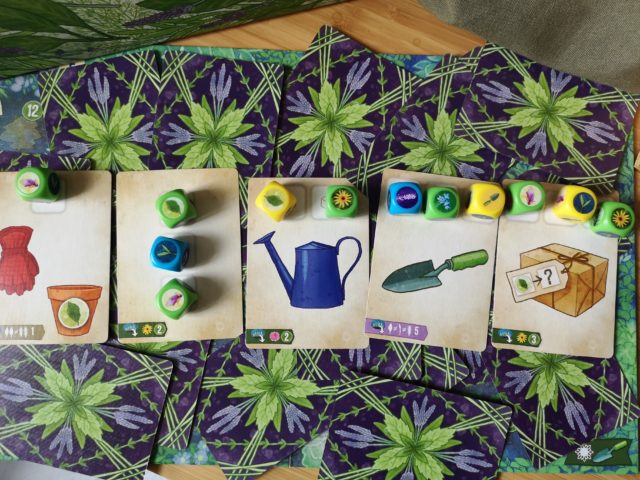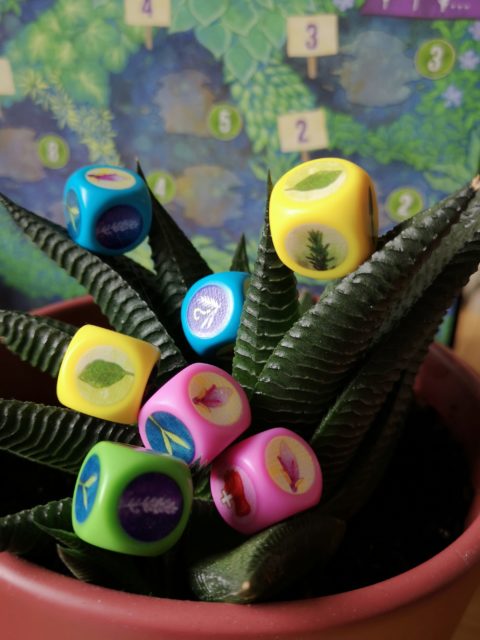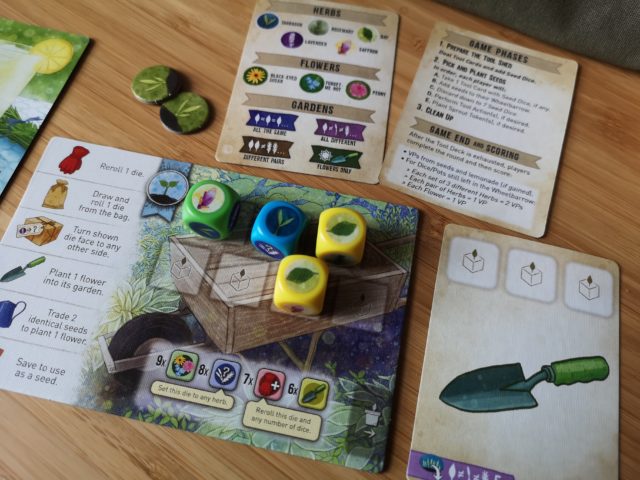There have been a lot of great transformations of original board/card games into dice games – perhaps my favourite being Pandemic: The Cure. It takes some nuance to make sure that the feel of the game doesn’t get lost in the translation of the format. And some folks out there might ask – why do we need different formats of a game, anyhow? It’s certainly a valid question, considering the number of games we’re seeing come out every year – I like to think of these as niche sorts of experiences, for folks who maybe enjoy the parent game but don’t have time for it, if they want a streamlined experience, or (in the case of co-ops) the opportunity for a player to dominate is too strong. I really wasn’t sure where Herbaceous Sprouts would land for me – I enjoy the card game and wasn’t quite sure what a dice game could do for me. I was pleasantly surprised to discover that it actually tinkers with the idea of the game quite a bit and gives players more decisions to make and some fresh new additions to the game.

In Herbaceous, players have a choice between 2 cards on their turn and are aiming to create sets throughout the game. Sprouts puts a spin on this by making the game a combo of card/dice drafting, and in addition to collecting sets to plant, offers up a new gardening option with the flower bed where one sprout at a time is played. A round consists of cards being laid out (number of players +1) and if there are places for dice, the “lead gardener” for that round rolls & places the appropriate amount and then starts off the drafting. Sometimes there are just dice to take, but Sprouts introduces “tool cards” that you might take along with the dice to use straight away, or save for further turns. Dice are tucked away on your wheelbarrow (player board), and if you choose to plant you do so – returning dice as they’re used.
The introduction of the tools gives the drafting portion of the round some more meaningful choices, and the tools themselves allow players some more interaction with the game itself, especially luck mitigation which can be a huge deal in a game of dice. Glove cards for rerolling, pots for saving seeds, and the ability to get extra dice and also change the face of certain dice, mean that you can aim a little better for the sets of herbs you want to plant. Similarly to the card game, you’ll be after all the same herbs, all sorts of different herbs, or different pairs – and because you’ve moved out of your little container garden into a bigger plot, each of these categories has a number of places to plant. For instance, you could get in with 6 of the same type of herb for an astounding 12 points at game-end, or 3 different pairs for 9 points. These three plots of the garden offer a number of choices (so if you miss out on the spots for 2 different pairs, you can always throw just one down). And there’s also the opportunity to plant some flowers to pretty up the place, planting one of these at a time for single spots that decrease in value depending on when you get in there.

The interaction in Sprouts seems a little better to me than in Herbaceous itself. There are more decisions to be made in the drafting phase, and you’re absolutely looking at other players’ wheelbarrows to see what sorts of sets they’re working toward to see if you can sneak in for more points first. Not only that, but you can get the refreshing reward of a couple of extra points by being the first player to plant in all 4 plots, gaining the lemonade card. In a 2 or 3 player game, there are also some “rival sprouts” introduced to keep players on their toes. Whichever card is not drafted will be examined for directions that specify the location of a rival sprout to be placed, thus blocking off others from those points. So you all want to be eyeing up those while drafting your cards to make sure your best-laid plants won’t go to waste.
As always, the quality of the Pencil First Games line is great – and having Beth Sobel come back to create a little more art (cute sprouts, lovely flowers!) for this game keeps the lovely pastel vibe of the card game going for this. The dice are a lovely custom affair, transfer printed with the variety of symbols required for the game – not just the herbs and flowers but also the options for tool use. Nothing here feels cheap – yes, not even the dice bag – and it’s always a pleasure to play a game that not only looks good but feels nice, too.

If you’re really down with the simplicity of Herbaceous, then Sprouts might kick things up a notch too far for you. But for me, Sprouts provides a little more meat (plant?) for me to dig my teeth into. It definitely feels like a more full game, and it’s really fun having the dice to make sets with. The central garden versus my personal collecting wheelbarrow also makes things more interesting and somewhat more flexible for gameplay. Make no mistake, the game hasn’t photosynthesized into a European-style strategy game, but it’s a great weight for a casual sit down to play, or for winding down and giving your brain a little peace after something heavier. Grab your trowel and get planting!
—
Herbaceous Sprouts is a dice drafting set collection game for 1 – 4 players that plays in approximately 30 minutes. Designed by Eduardo Baraf & Steve Finn (with solo rules from Keith Matejka), and art by Beth Sobel, it’s published by Pencil First Games and is available in retail now.
Comments
No comments yet! Be the first!